
JULIA LEE BARCLAY-MORTON – YOGA, WATER AND REWRITING AUTISM
I interviewed writer Julia Lee Barclay-Morton about her experience of autism. Julia began as an experimental dramatist in New York, moving to the UK to
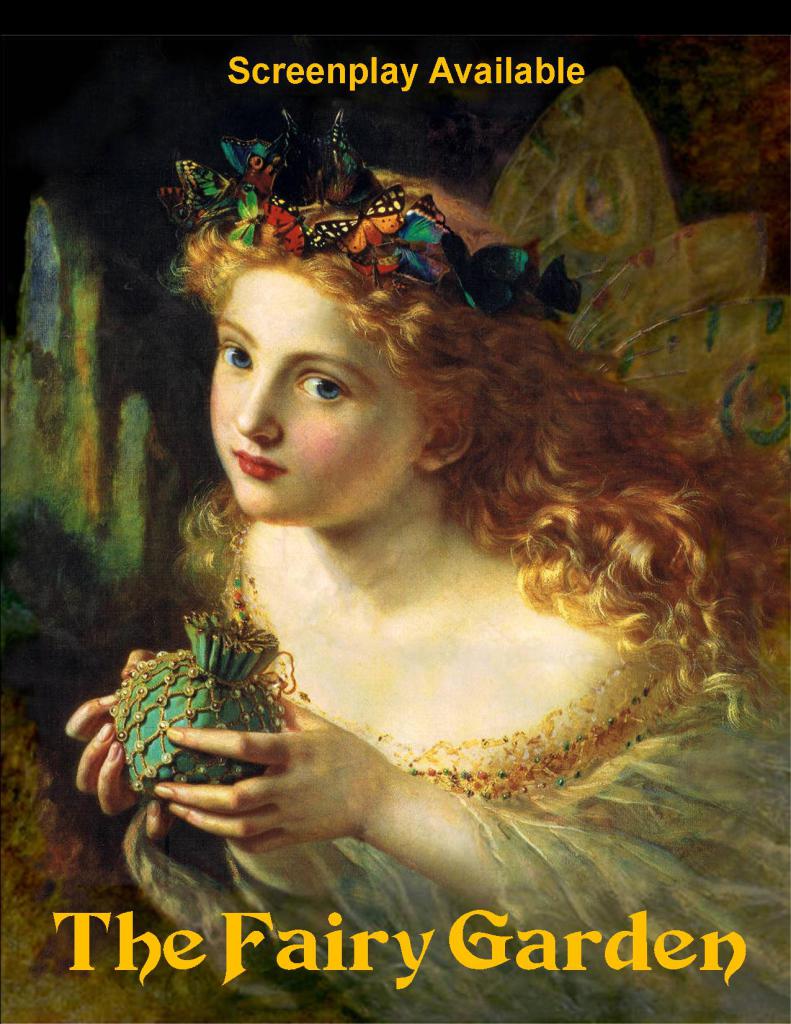
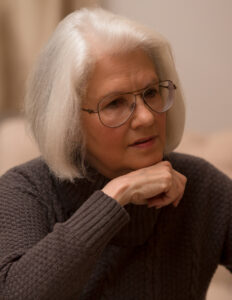
I interviewed Katherine Ashe whose historical fiction, Montfort, stayed 30 weeks on the Amazon best-seller list. As Katherine says of herself: “In addition to researching and writing Montfort for 35 years, I’ve also written plays and screenplays on historical subjects, ranging from ‘An Evening with Edgar Allan Poe’, commissioned by the New York City Historic House Trust, to ‘Supper with the Pope’ on the Borgias on the beginnings of Western versus Islamic imperialism, and ‘The Treasure’ about a convent in France where, during WWII, the starving nuns rescued British flyers and hid the Belgian national treasure.”
Leslie: You’re a historian, interested in historical fiction. Can you trace the development of these two passions from childhood onward, please?
Katherine: My father was a screenwriter for Cecil B. DeMille. (Unconquered, Samson and Delilah, The Greatest Show on Earth, The Ten Commandments – then El Cid on his own.) I found his research fascinating. Researching and writing about Simon de Montfort felt very much like being my father’s daughter, except that after two years my father felt very weary of Rodrigo Diaz de Bivar (El Cid) but I never tired of Simon.
Leslie: What methods did you use during the 35 years you spent researching Simon de Montfort’s life? Could you explain why you chose him, or he chose you?
Katherine: Finding historians contradicting each other, I focused on original 13th century documents.
In a strange way, Simon did choose me. Here’s how that happened: I had a fine art print publishing company. (I hired well-known artists to work with screen printers, lithographers, etc. to produce small editions of prints by their own hands.) The fine art print market collapsed in 1976, taking my company, Contemporary Artists, Inc., down with it. To escape from the stress, I wrote a novel. The previous summer I’d visited Salisbury, England and took photos of the cathedral’s North Canonry Garden. In the bleak winter of my company’s demise I got the photos printed and found myself exclaiming at the dew-drop-necklaced fuschias, “If there are fairies anywhere, they’re in the North Canonry Garden!” The book, The Fairy Garden, became a work about perception: the seen and the unseen. Since it was centered on the grounds of Salisbury Cathedral I thought I should know more about the history of the place.
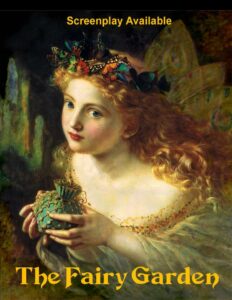
Hauling out my Encyclopedia Britannica, I found the cathedral had been completed and consecrated in the year 1258. So I looked up what was happening in England that year and discovered the Barons’ War, led by Simon de Montfort, Earl of Leicester.
This struck me like a blow in the face. In the second chapter of The Fairy Garden, written weeks earlier, I had invented a character named Alice Montfort, in love with an Elizabethan ancestor of my principal character. I thought I’d made up the name. Needing to create a desperate cause for elopement, I wanted her father to be intent upon marrying her off to a man one would least want a nice girl to wed. I’d hit upon Robert Dudley, Earl of Leicester, suspected of murdering his wife. On Alice’s father I bestowed the motivation that he imagined his family had a claim on the earldom of Leicester. (All this argues that I must have unconsciously known of a Montfort Earl of Leicester. What I could not have known, and only learned after years of research, was that Simon’s mother was named Alice de Montfort.)
I next looked up what the Britannica had to say about Simon de Montfort. Although I thought I’d never heard of him before, I found the encyclopedia’s little biography very disturbing, offensive and negative to the point of calumny. I was perplexed by my reaction, doubting the Britannica when I admittedly knew nothing about the man.
I returned to writing The Fairy Garden and all but forgot about Simon until two weeks later when I attended the reopening of my local New York City library. The Ottendorfer had its book stacks angled in a herringbone fashion so that, from the back of the room, the end of each stack was visible. As I stood at the back, sipping a lurid punch, my very nearsighted eyes were caught by a dab of green, a set of green bindings far down the aisle. I went over and, without looking at the title, I pulled one of the books off the shelf and let it fall open. The page it opened to described Simon’s death at the battle of Evesham. Far from the Britannica’s disparagement, this author wrote of Simon with the highest praise.
The book was Green’s History of the English People. I learned later that Green was an American, free to celebrate Simon as the founder of modern democracy. The Britannica’s negative account of him was still laboring under the 700 year ban in England that forbade any positive mention of the creator of Parliament, crediting the institution instead to the man whose army killed Simon and who suppressed the Parliament, King Edward I.
I shut Green’s book, determined that the next thing I would do in my life was find out all I could about Simon de Montfort and write about the man I now saw as one of the most pivotal, and neglected, persons in history.
Leslie: Could you give an idea of how the books you’ve written about Simon de Montfort have turned out, and what you were aiming to achieve?
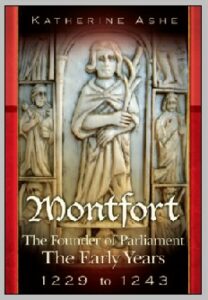 Katherine: Montfort The Early Years was thirty consecutive weeks on Amazon’s historical novel best seller list – which has made me very happy.
Katherine: Montfort The Early Years was thirty consecutive weeks on Amazon’s historical novel best seller list – which has made me very happy.
The process: I began researching Montfort in 1977 and took my first chapter and an outline to my agent; I had written heavily researched books on Chinese art, previously. My agent was thrilled with my new work and called me with a book contract within two weeks. The contract was with Playboy Press. I told him I wouldn’t touch Playboy Press with a barge pole and Montfort certainly wasn’t their sort of book. Why had he gone to them? He said they paid the most. I said clearly I had to complete this book before offering it out again.
By 1985 I had traveled to most of the places where Simon had been, had delved through 13th century documents in the Bibliotheque Nationale in Paris and London’s Public Record Office and the British Library, and had completed my first draft, some 1500 pages. (I’d brushed up on my Latin and learned Old French.)
Again the manuscript was well received, but historical novel publishing had changed. There was a determined effort to move away from the white male protagonist and place the focus on women.
Editors, from 1985 to 2008, all gave me the same ultimatum: I must change my main character to a woman if I wanted the book published. Since my book adhered absolutely to my research and I was intent upon telling the true story as fully and closely to the actual events that research and reasoning enabled, I could not make the principal character a woman. There were no women through whom I could tell the story.
I continued my research, finding more and more of the bits and pieces that clarified events and brought Simon’s life and the advent of Parliament into focus.
For example, Simon was accused of seizing dictatorial power after the meeting in Oxford that created the Provisions of Oxford, the ‘constitution’ that defined Parliament. What no subsequent historian mentioned was the mass poisoning at Winchester of nearly all the lords attending the meeting – a horrific event the chronicler of the period, Matthew Paris, records three times. Matthew even writes of the finding of the remains of the poison in the home of King Henry III’s half-brother Amaury, the poison’s color and composition and the symptoms of the poisoning. Through the services of The Mystery Writers of America’s consulting physician, Dr. Lyle, I was able to identify the poison as powdered mercury.
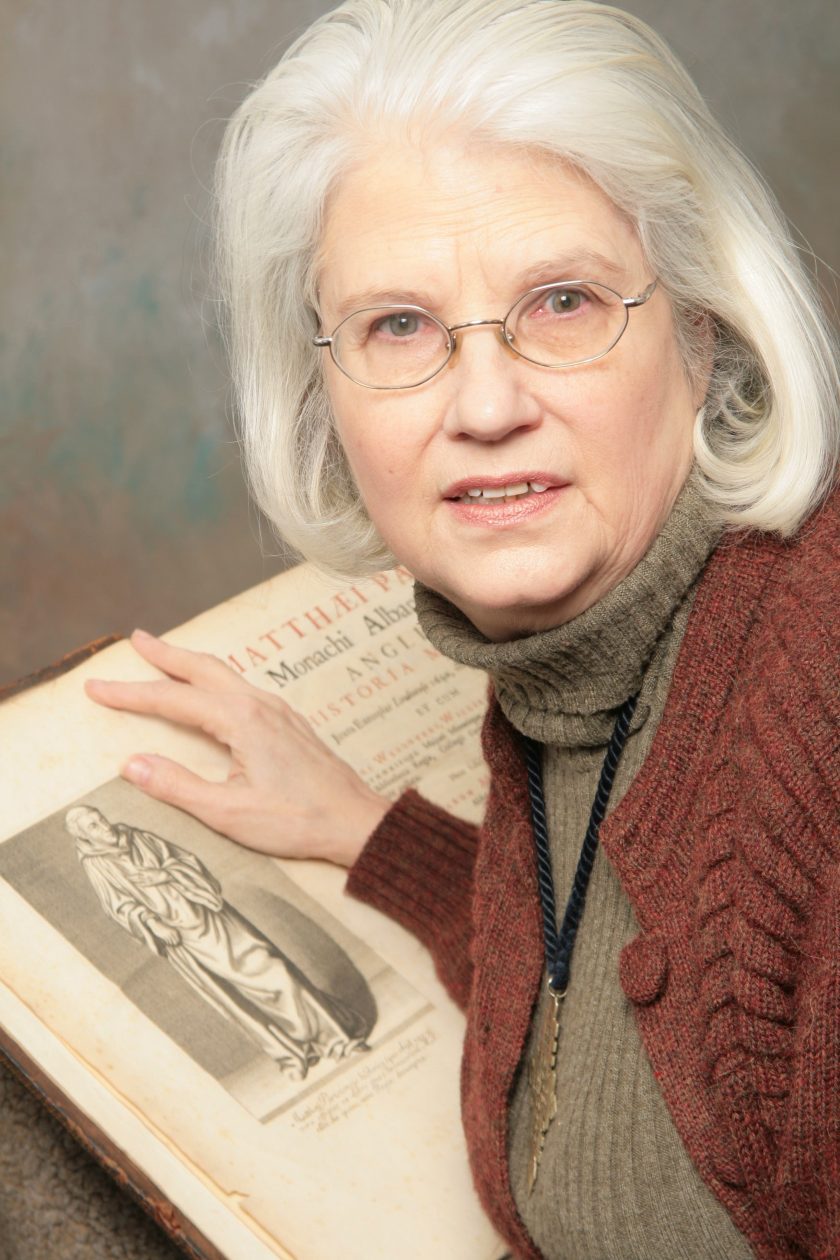
Simon, having alone remained behind at Oxford to put into effect the program set out by the Provisions, was literally the only lord ‘left standing’. Mention of the poisoning is eliminated from most of the reprints of Matthew’s chronicle but I had been able to obtain the 19th century 7-volume translation and two complete 16th century copies. The suppressed information transformed Simon from a power-grabbing dictator to a man fulfilling the lords’ promise despite their mass murder and attempted murder by the King’s half-brother.
By 2008 I despaired of trade publishers and decided to publish Montfort myself. After rearranging the work’s now 1650 pages into four volumes, I contracted with BookSurge. The moment was propitious, BookSurge was being bought by Amazon and became CreateSpace, and my contract for Montfort the Early Years was the first book contract under the new organization.
I had intended to use Simon’s shield, as depicted in Matthew Paris’s Chronicle, the original of which is housed in the British Library, for the cover image. But the Library wanted about $800 for a limited eight year use. I had bought at auction, some years previously, a pair of ivory plaques made in the 13th century with an iconography that suggested the central image on one of the plaques might have a double meaning. Ostensibly it showed Christ on Palm Sunday, but many of the saints surrounding and on the facing plaque related to resistance to unjust kings, (Saint Dominic who was a close friend of Simon’s father.) After Simon’s death a cult grew up, not merely holding Simon to be a saint, but to be the Angel of the Apocalypse bringing in the New Era of Democracy. The cult was suppressed on pain of death. Could this ivory be a relic of that cult?
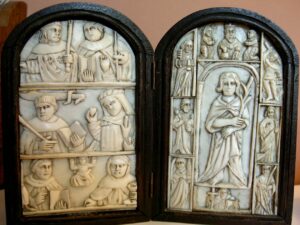 I tried a photo of the ivory for my book cover. The result is peculiar and not particularly attractive. With misgivings I showed it to friends in publishing and an art director friend. They loved it and urged me to go ahead with the ivory image. I haven’t regretted it. The cover is unique and holds up well in thumbprint size as seen on line…
I tried a photo of the ivory for my book cover. The result is peculiar and not particularly attractive. With misgivings I showed it to friends in publishing and an art director friend. They loved it and urged me to go ahead with the ivory image. I haven’t regretted it. The cover is unique and holds up well in thumbprint size as seen on line…
Next week, in Part Two of her interview, Katherine Ashe describes her involvement with film production, how she works as a writer and her views on fiction versus fact in historical novels.
ABOUT LESLIE TATE’S BOOKS:

I interviewed writer Julia Lee Barclay-Morton about her experience of autism. Julia began as an experimental dramatist in New York, moving to the UK to

I interviewed Gillean McDougall from Glasgow, who edited the collaborative projects Honest Error (on Charles Rennie Mackintosh and his wife Margaret Macdonald) and Writing the

I interviewed French writer Delphine de Vigan, whose book, No et moi, won the prestigious Prix des libraires. Other books of hers have won a clutch

I interviewed Joanne Limburg whose poetry collection Feminismo was shortlisted for the Forward Prize for Best First Collection; another collection, Paraphernalia, was a Poetry Book Society Recommendation. Joanne

I interviewed Katherine Magnoli about The Adventures of KatGirl, her book about a wheelchair heroine, and Katherine’s journey from low self-esteem into authorial/radio success and
| Cookie | Duration | Description |
|---|---|---|
| cookielawinfo-checkbox-analytics | 11 months | This cookie is set by GDPR Cookie Consent plugin. The cookie is used to store the user consent for the cookies in the category "Analytics". |
| cookielawinfo-checkbox-functional | 11 months | The cookie is set by GDPR cookie consent to record the user consent for the cookies in the category "Functional". |
| cookielawinfo-checkbox-necessary | 11 months | This cookie is set by GDPR Cookie Consent plugin. The cookies is used to store the user consent for the cookies in the category "Necessary". |
| cookielawinfo-checkbox-others | 11 months | This cookie is set by GDPR Cookie Consent plugin. The cookie is used to store the user consent for the cookies in the category "Other. |
| cookielawinfo-checkbox-performance | 11 months | This cookie is set by GDPR Cookie Consent plugin. The cookie is used to store the user consent for the cookies in the category "Performance". |
| viewed_cookie_policy | 11 months | The cookie is set by the GDPR Cookie Consent plugin and is used to store whether or not user has consented to the use of cookies. It does not store any personal data. |
6 responses
An excellent interview and my admiration for the perseverance and dedication to Simon Montfort and his story. I wonder how many other excellent books we have lost because of the short-sightedness of publishers and their marketing departments? Congratulations Katherine.
Thank you, Sally, you’re so right. Fortunately we didn’t lose this book, but it took a long time and a great deal of persistence on Katherine’s part to reach the audience it deserved!
A very interesting article on the development of this historical novel. A real labour of love, I am sure. I do not understand this recent English obsession with the promotion of women. Surely we should be sufficiently far along now to have a fair society that promotes on merit and not gender.
Thanks, Robbie. I wish I could agree with you about women’s opportunities but I don’t personally think we have got that far. On the other hand I do think it was absurd for editors and agents to try to force Katherine to write the whole narrative through the eyes of a woman who didn’t exist.
Fascinating article.
A fascinating interview and kudos to Katherine Ashe for her determination to tell the true history. We are finding out more these days of the “true history” against the lies we have been told.